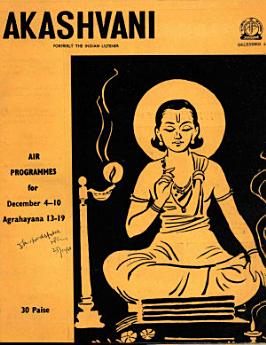AKASHVANI: Vol. XXXI, No.49 ( 4 DECEMBER, 1966 )
About this ebook
The Indian Listener (fortnightly programme journal of AIR in English) published by The Indian State Broadcasting Service, Bombay, started on 22 December, 1935 and was the successor to the Indian Radio Times in English, which was published beginning in July 16 of 1927. From 22 August ,1937 onwards, it used to published by All India Radio, New Delhi. From 1950,it was turned into a weekly journal. Later, The Indian listener became "Akashvani" (English ) w.e.f. January 5, 1958. It was made fortnightly journal again w.e.f July 1,1983.
NAME OF THE JOURNAL: AKASHVANI
LANGUAGE OF THE JOURNAL: English
DATE, MONTH & YEAR OF PUBLICATION: 04 DECEMBER, 1966
PERIODICITY OF THE JOURNAL: Weekly
NUMBER OF PAGES: 80
VOLUME NUMBER: Vol. XXXI, No.49
BROADCAST PROGRAMME SCHEDULE PUBLISHED (PAGE NOS): 12-79
ARTICLE:
1. The State of Our Economy: Agricultural Production
2. Early Indian Sculpture
3. The Image of India Abroad: In South East Asia
4. On Writing A Book
5. Book Review
AUTHOR:
1. Dr. V. K. R. V. Rao
2. Dr. Charles Fabri
3. Dr. Vishal Singh
4. Nayantara Sahgal
5. P. N. Jungalwala
KEYWORDS :
1. Upward Production Trend, The Shortcomings, How To Rectify Drawbacks, Better Coordination, Freedom From Monsoon Failures.
2. Persian Master-Masons, Indians Astonishing Ability.
3. What They Know of India, Religious Influence, Study of Sanskrit, Our Role In Their Freedom, A Pessimistic Picture, Our Failure.
4. Writing A Novel, In Love With Life.
5. The Glory and the Good.
Document ID : APE-1966(Oct-Dec)Vol-I-10
Prasar Bharati Archives has the copyright in all matters published in this “AKASHVANI” and other AIR journals. For reproduction previous permission is essential.
About the author
As India’s National Broadcaster and also the premier Public Service Broadcaster, All India Radio (AIR) has been serving to inform, educate and entertain the masses since it’s inception, truly living up to its motto – ‘Bahujan Hitaya : Bahujan Sukhaya’. One of the largest broadcasting organisations in the world in terms of the number of languages of broadcast, the spectrum of socio-economic and cultural diversity it serves, AIR’s home service comprises 479 stations , located across the country, reaching nearly 92% of the country’s area and 99.19% of the total population. AIR originates programming in 23 languages and 179 dialects.











